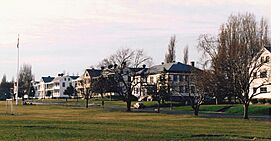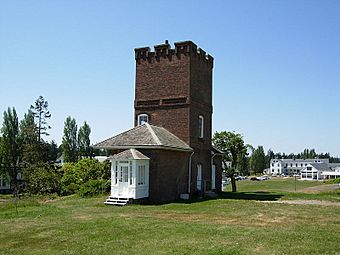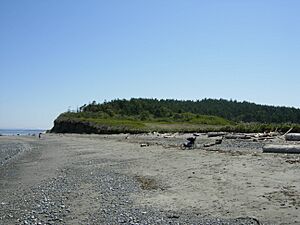Fort Worden facts for kids
Quick facts for kids Fort Worden Historical State Park |
|
|---|---|

Historic buildings at Fort Worden
|
|
| Lua error in Module:Location_map at line 420: attempt to index field 'wikibase' (a nil value). | |
| Location | Port Townsend, Washington, United States |
| Area | 432 acres (175 ha) |
| Established | 1973 |
| Administered by | Washington State Parks and Recreation Commission |
|
Fort Worden
|
|

Alexander's Castle at Fort Worden
|
|
| Location | Cherry and W Sts. Port Townsend, Washington |
| Architect | US Government War Dept. |
| NRHP reference No. | 74001954 |
| Significant dates | |
| Added to NRHP | March 15, 1974 |
| Designated NHLD | December 8, 1976 |
Fort Worden Historical State Park is a cool place in Port Townsend, Washington. It covers about 433 acres and used to be a big army base called Fort Worden. This fort was built to protect Puget Sound from attacks by sea. It was named after U.S. Navy Rear Admiral John Lorimer Worden, who was famous for commanding the USS Monitor during the American Civil War.
The fort was built between 1898 and 1920. It was one of the largest forts of its kind and was special because it was built on new land. It was even close enough to see a British Navy base in Canada, though they were not enemies. In 1976, Fort Worden was recognized as a National Historic Landmark because of its important history.
Contents
History of Fort Worden
Fort Worden was an active United States Army base from 1902 until 1953. After the army left, the land was bought by the State of Washington in 1957. It was first used as a place for young people who needed help. Then, in 1971, it became a state park, officially opening in 1973.
Why Fort Worden Was Built
In the 1890s, the entrance to Puget Sound was a very important spot for defense. Three forts were built there: Fort Worden, Fort Flagler, and Fort Casey. These forts created a "Triangle of Fire" with their powerful cannons. Their job was to stop any enemy ships from getting into Puget Sound. Fort Worden was on the Olympic Peninsula, guarding one side of this triangle. The forts protected important places like the Puget Sound Naval Shipyard and cities like Seattle and Tacoma.
Even though they were ready, these forts never had to fire their guns in a real battle. Many of the cannons were taken away during World War I to be used in Europe. Any remaining guns that were old-fashioned were removed during World War II. After that, Fort Worden was used for training soldiers and other defense activities.
Building the Fort
The oldest building at the fort is Alexander's Castle. It's a brick house built in 1883, even before the army arrived. It belonged to a British church leader named Reverend John Barrow Alexander. The government bought the building in 1897.
Building Fort Worden started in 1897 and continued for many years. The Army Corps of Engineers built docks, warehouses, and a special railway. This railway helped move heavy concrete from the dock to where the gun placements were being built. All the cement for the fort came from Belgium, traveling all the way around Cape Horn by ship. It took about 200 workers almost three years to dig and pour the concrete for the gun areas.
By March 1900, the fort was ready for its guns. Sixteen cannons arrived from Ohio by barge. Another special railway was built to move these huge guns from the dock to the top of the bluff. In March 1901, the guns were in place and ready to be tested.
Fort Worden officially opened in 1902. The first soldiers, 87 of them, arrived in May 1902. They lived in tents while their barracks were being built. By 1905, Fort Worden had many soldiers and was fully ready to defend the harbor. It had 41 cannons, including very large ones and mortars.
Military Life at the Fort
During World War I, many more soldiers came to Fort Worden for training before going to fight in Europe. New buildings were added to house everyone. Most of the fort's cannons were sent away for the war and were never replaced. After the war, fewer soldiers were stationed at the fort.
Over time, warships and weapons changed a lot. Fixed cannons like those at Fort Worden became less useful. In the 1920s, a large hangar was built for observation balloons, which were used to watch for enemies.
During World War II, Fort Worden was still important. It was the main base for defending the harbor and was run by both the Army and Navy. Soldiers and sailors worked together to watch for enemy ships and planes. They used radar and underwater sensors. Anti-aircraft guns were also installed to protect against air attacks.
After World War II, the fort's army units were disbanded, and the remaining guns were removed. Fort Worden officially closed as a military base on June 30, 1953, after 51 years of service.
After the Korean War, the 369th Engineer Boat and Shore Regiment was stationed at Fort Worden for training. This unit was demobilized in 1953.
In 1957, the State of Washington bought Fort Worden to use as a center for young people.
Fort Worden's Batteries
Fort Worden had many different types of coastal artillery batteries. These were places where large guns were set up to defend the coast.
- Primary Batteries: These included batteries like Randol, Quarles, Ash, Benson, and Kinzie. They held very large cannons, some up to 12 inches in size. Some of these guns were on "disappearing carriages," which meant they could pop up to fire and then hide again.
- Secondary Batteries: These included batteries like Tolles, Stoddard, Vicars, Putnam, and Walker. They had smaller guns, like 6-inch and 3-inch cannons.
- Mortar Batteries: Batteries Brannan and Powell held large 12-inch mortars. Mortars fire shells high into the air, making them drop down on targets.
All the original cannons and their mounts were removed in the 1940s. So, you won't see any of the old guns there today.
Fort Worden State Park Today
The Washington State Parks and Recreation Commission took over Fort Worden in 1971, and it opened as a state park in 1973. Today, this 433-acre park is a popular spot for people to visit. It has over 2 miles of sandy beaches and tall bluffs.
You can explore the many large, old artillery batteries, but remember they close at dusk. The park also has the Puget Sound Coast Artillery Museum, where you can learn more about the fort's military past. There's even a balloon hangar that was used for observation balloons. You can also rent some of the historic officers' quarters for a unique vacation stay. The Point Wilson Lighthouse is also located here.
The Commanding Officer's Quarters on Officers' Row has been restored to look like it did in the early 1900s. You can take tours there in the summer.
The park is home to the Port Townsend School of Woodworking, where people learn how to work with wood. A poetry publisher, Copper Canyon Press, has been at Fort Worden since 1974. The Port Townsend Marine Science Center is also here. It has a museum and hands-on exhibits to teach visitors about ocean life.
You might be interested to know that parts of the 1982 movie An Officer and a Gentleman and the 2002 movie The Ring were filmed at Fort Worden.
Goddard College also uses some of the old hospital buildings at Fort Worden for its programs.
One really cool feature of the park is a huge underground cistern. It was built to hold 2 million gallons of water for fighting fires if the fort was ever attacked. When the fort closed in the 1950s, the cistern was emptied. This created a giant underground room, over 200 feet wide and 14 feet deep. It has amazing acoustics, meaning sounds echo for a very long time, about 45 seconds! Musicians have been interested in using it for recordings. However, since 2014, the cistern has been sealed off and is not open to the public.
Military Cemetery
There is a small military cemetery at the south side of the state park. It is cared for by the Public Works Directorate at Joint Base Lewis-McChord.
See also
- 14th Coast Artillery (United States)



